



Home page
My Fishing Blog
My Fishing Videos
Links
Contact Me
Recommended
Montreal fishing guides
Purchase hair rigs
Fishing trips/outfitters
Charity bounty program
Reading/publications
Memorial for my Dad obm
Montreal fishing spots
Fishing tips
The Frum Fishaholic (my book)
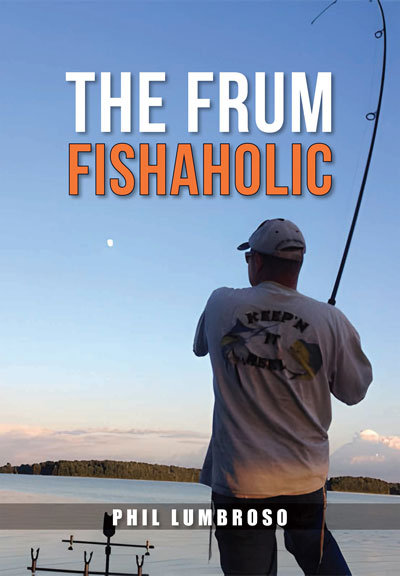
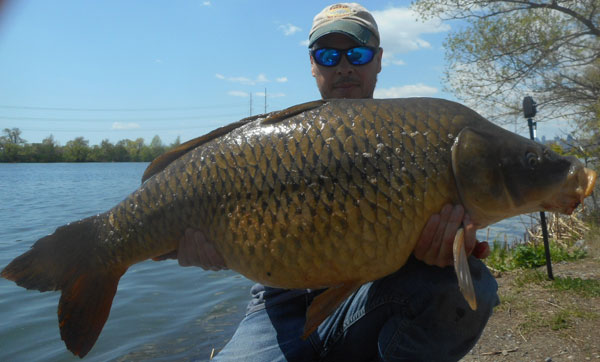
Carp are among Canada’s most under-rated game fish. Talk to most Canadian sport fisherman about fishing for carp, and you’re likely to get some funny looks, possibly some surprised reactions. But for those of us that have experienced the raw power these big suckers can generate with 150 foot runs, we know good and well that there aren’t too many freshwater fish swimming in Canadian waters that can keep up a sustained fight at that level except for sturgeons and very big channel catfish.
About carp in Canada
Common Carp are not native to Canadian waters. They were originally imported and stocked here by Europeans, as an eventual source of food. Being and extremely tough and adaptable fish, they took quite well in many of our big waterways. Not being the choicest table fare due to their strong flavor and extremely bony flesh, they eventually faded away as the major food source they were originally intended to be. Though the St Lawrence River still has some commercial carp fishing, it is targeted to a few ethnic groups such as Eastern Europeans and certain Asians, where carp is considered a delicacy. However, to most other Canadians, it is viewed as a nuisance fish, often blamed destroying habitat required by other fish and eating their eggs.
Unlike countries in Western Europe where carp fishing is a craze and regarded as the top of the sport fishing world, carp fishing in Canada is still relatively untouched and very much in it’s developmental stage. Up until a few years ago, most carp fishing was done with bows and arrows, as opposed to rods and reels. They were easy targets during their spawning period, when you can find hundreds or them splashing around near the surface in shallow waters. These bow fisherman simply killed them, often leaving the carps to rot in garbage cans, although some did make use of them as fertilizer or bear hunting bait.
Personally, I don’t believe in killing carp unless I know someone will eat them. Though I don’t eat them, I know some people that do, and they are quite happy when I bring them some carp once in a while. When I do keep some for these people, I practice sustainable/selective harvest, keeping the smaller ones and releasing the bigger ones, which apparently taste a lot worse too.
Carp habitat
Carp can be found in major rivers such as the St Lawrence, Ottawa River, etc., including their tributaries and connecting waterways. They are also present in the great lakes, Lake Champlain, the Kawarthas. They typically spend most of the fishing season in shallow bays, favoring areas away from the main current.
Carp feeding habits
Carp are bottom feeders, using the sucker like mouth to inhale their food, typically made up of crayfish, zebra mussels and small aquatic insects or worms when left alone in their natural habitat. Carp are extremely opportunistic feeders, and can quickly get accustomed almost any food source, having a very high tolerance for food designed for human consumption. It is common for carp to get accustomed to feeding on bread, chips, fries, crackers, pop corn and other types of junk food people often feed to birds or simply throw into the water. Once carp in a particular area get accustomed to being fed, they will quickly learn to congregate where they free food source is abundant, often become docile to literally be hand fed. Using the carp’s adaptability to certain food groups to your advantage, is the first step to successful carp fishing.
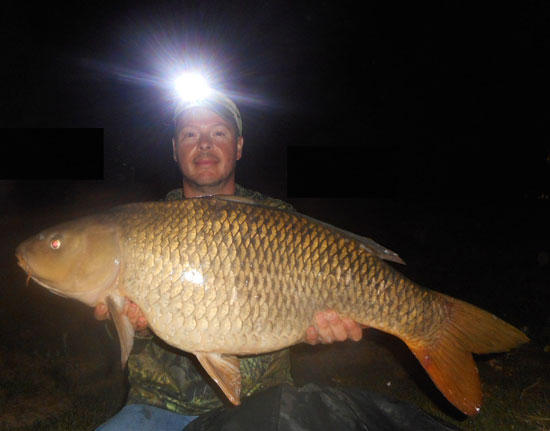
Carp fishing gear and tackle
For the purposes of this article, the gear, tackle and methods listed are the most simple yet efficient ways of catching carp, without getting into fancier (expensive) specialized carping gear imported from Europe.
Carp fishing rods
The gear and tackle used to catch carp will depend on the type of waterway you are fishing for carp. I prefer to use medium action rods, anywhere from 9 to 12 feet in length, though I’ve caught many on 6 – 6.5 medium light rods as well. Avoid using stiff catfish/sturgeon type rods, as they will only increase your chances of tearing the hook out of their mouths, while reducing the feeling you get from fighting a big fish. My personal preference for a carp rod are 9 foot Ugly Stik from Shakespeare, and 12 foot Black Widow or MadDragon rods from Daiwa. The latter are offered in different test curves. My preference is a 2.75 lbs test curve, as I don't typically cast great distances. To me, they have perfect balance of power and sensitivity, also being very reasonably priced.
Carp fishing reels
The vast majority of carp fishing tactics are based on still fishing, either with sliding floats or bottom rigs. It is vital to fish carp with extremely loose drag (less than 1 lb of resistance) in order to avoid losing your equipment. Carp get extremely spooked as soon as they realize that they are hooked, which result in powerful initial runs. If you drag is too tight, you rod will disappear in a hurry.
Fishing reels in the 40’s, 50’s and 60’s series are ideally suited for most carp fishing needs are described in this article. Most hold several hundred feet of line. The ideal real used by most carp fisherman is a baitrunner / liveliner type of reel. These reels have 2 drag systems. The baitrunner drag setting is used at the low drag setting, usually engaged with a flick of a button or lever in the bottom of the reel. As soon as the fish runs, reeling ¼ turn will engage the standard drag system, set at a higher resistance.
Carp fishing line
It is extremely important to have lots of quality line spooled up on your reel, as carp are generally fished with less drag resistance than most other fish. This is due to the combination of the small size hooks being used to pull in powerful fish with relatively soft mouths. Trying to horse a carp will often result in the hook tearing from its mouth, or possibly equipment failure. My preference is using a good superbraid line, although many carpers use a 30-40 foot monofilament shock leader to give the line some stretch. Line strength and diameter should be the thinnest you can get away with without losing too many fish. In waterways with not too much rocks, a 20 lb to 30 lbs superbraid is more than enough. Its thin 6-10 lbs diameter will results in more hookups. In big waterways with sharp boulders cover in Zebra mussels such as the St Lawrence, even 50 lbs Power Pro won’t do the trick, often getting sliced like butter with a hot knife by big carp running for rock cover at high speed. To date, my favorite is 65 lbs Sufix 832, the newest superbraid from Rapala. In extreme instances, I use a heavy mono shock leader, as mono line is a lot heavier and more resistant to zebra mussel covered rocks. So far, 80 lbs Sufix is my line of choice, after having 50 lbs test Trilene Big Game cut a number of times. For instructions on joining heavy mono to thin braided line, click here.
Carp hooks
Fishing hooks used to catch carp are surprisingly small in comparison to what most Canadians are used to. While a bass fisherman will often chase 3-4 lbs bass with 3/0 – 5/0 hooks, most carp fishermen will rarely exceed and #4 sized hook, often going smaller than #10. Good carp hooks are truly sticky sharp, more so than most hooks available from the big North American companies. My personal favorites are the Kamasan B725 or B775, Fox Arma Point SSC, and Gamakatsu G Carp hump. These are all curve shank hooks, and my preference is the #4 size.
Carp fishing setups and rigs
There are many combinations of effective rigs used to fish carp. Again, to keep this article simple, we’ll focus on a basic bottom rig, which will be effective in most situation unless heavy weed cover is an issue. Any form of sliding sinker should do, my preference are 2 - 3 ounce egg (or no roll) sinkers, followed by a decent quality swivel. That should be followed by a 12 inch “hooklink”, typically a hair rig.
The hair rig is one of the greatest innovations to carp fishing. The general idea is to mount the bait to the line about ½ an inch away from the hook. While carp usually inhale a spit out bait a number of times before deciding to swallow it, when the carp inhales the bait on a hair rig, spitting out the sticky sharp / fully exposed hook without being hooked, is less likely.
Click to buy custom tied hair rigs
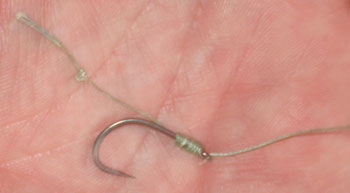
Specialized carp fishing gear
Here is a quick list of miscellaneous carp fishing items you will probably find quite useful:
- Baiting needle: Used to rig bait onto hair rigs, you may use a straightened out wide gap bass hook too.
- Bait stops: You can opt to purchase these, or use cut pieces of twist ties, rubber bands, etc. The stop the bait from coming off the hair rig.
- PVA: Material that melts on contact with water, used precision chumming bait next to your hookbait. Typically tied to your rig, available in string, tape, mesh or bag forms.
- Catapult/Throwing spoon: Use to propel bait further than you would be able to by throwing them out by hand.
- Rod holders: Any type of rod holder is an asset, from spikes, to bank sticks to fancier rod pods, to which bite alarms can be mounted.
- Landing mat: Small soft mat some carpers use to avoid possible injury to the carp once landed.
- Landing net: Be sure to have a large, strong landing net ready. The ones made with knotless mesh are more expensive, but a lot friendlier to the fish, ideally suited for catch and release.
- Scale: Handheld scale going up to 50 lbs do the trick, theough you can opt for a fancier setup such as tripod with weigh sling and larger capacity scale.
Other important items to bring along:
Folding chairs, camera, sunscreen, food, drink, possibly a big umbrella or even a tent if you intend to fish in the rain.
Carp bait: Particle baits
As previously mentioned, carp will adapt to a large variety of bait. So will many of the other species that share popular carp fishing waterways. The most popular by far is soaked or boiled corm nibblets. Under most circumstances, they are the go to bait of choice for most carpers. The simplest (and cleanest) way to fish with corn is to buy a bag of frozen corn in your local supermarket or grocery store. If you’re going to do lots of carp fishing and chumming, getting animal feed grade dried corn and soaking it is way cheaper, but be prepared to deal with the nauseating smell. Soaked corn is less likely to be eaten off by panfish or gobies. Prepared Tiger nuts are extremely effective as carp baits as well, but considerably more expensive.
Click to buy custom tied hair rigs
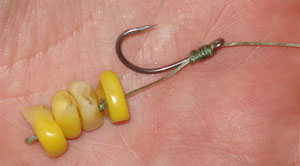
Carp bait: boilies
A boilie is simply a hardened dough ball, created to avoid small fish pecking away and eating the bait. Boilies are made by mixing base ingredients such as flours, flavor and scents with eggs, shaping them into the proper sized marble shaped balls, and boiling them for a few minutes. After air drying for a day or two, they will be ready to use. These boilies will mould if not used or frozen within a few days. Alternatively, you may be able to find “shelf life” boilies in various sizes, flavors and colors , from specialty carp fishing tackle shops. Once carp are onto boilies, they will typically produce larger size fish than particle baits such as corn nibblets.
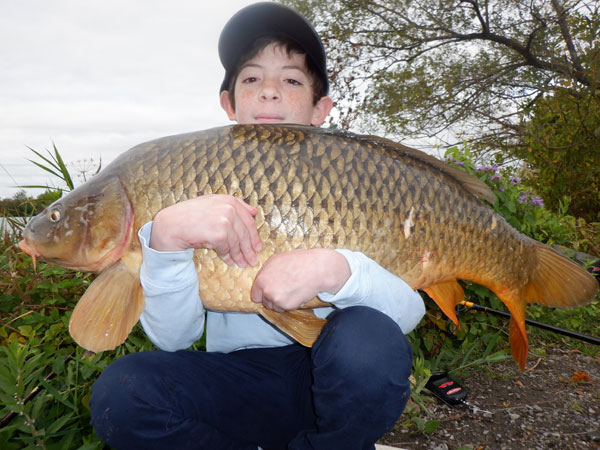
Locating carp
Now that we’ve got a general list of components required to get started, the next step is to find waterways with carp. Preferably big carp. Best way to find carp spots is to look for shallower bays away from the main current (in rivers) in waterways known to contain big carp. Starting in mid May, carp will surface and jump around, being visible from the bank. Stealth methods are important in close quarters, hiding in bushes or tall grass with slow movements is a good way to get a closer look. If you know of a local carp fishing tackle spot in your area, or of any other carp fishermen, you may be able to get accurate directions to a good spot.
Chumming for carp
Once a potential spot is located, you may begin to fish it right away. However, you are generally better off starting a chumming campaign to increase your chances, if you have the time to do so. If you plan to fish the spot immediately, cast the appropriate number of allowed lines a good 50 to 100 feet away from each other. Chum with the same bait used on your line, using a specialized catapult, throwing spoon, or at worst, by hand if possible. Be sure to chum as close as possible to your line. Corn is a great way to test the waters, and carp will begin feeding on them quite quickly.
To start a successful chumming campaign, plan to return to the same spot for a good 4-5 days in a row, preferably at the same time each day. Through in at least 1 kilogram of whichever bait you intend to use each day, the more the merrier. When you are finally ready to fish, return to your spot using the bait on your line, and chum small amounts at a time, every ½ hour or so. If you hook a carp, recast to the same spot and chum again once you’ve landed it. Start and maintain a chumming campaign in spring, and carp will often stick around until late in the fall
Fishing for carp
Carp will feed any time of day. In my experience, a change in weather such as increased wind or rain moving in will often get them feeding if the fishing is slow. Start by setting up your line(s) and casting them to you intended spot. Be sure to set you drag extremely loose or switch the reel into baitrunner mode. Secure you rod in a holder or properly balance (preferably horizontally) on rocks or logs. Chum sporadically to the area surrounding your baited line.
Carp runs and hooksets
When a carp inhales your bait and isn’t able to eject the hook, it will quickly figure out that something is wrong. In most cases this will spook it, and cause it to dart away at high speed. At this point, your rod will bend in half (if vertical), and your drag will start to “sing”, and you should feel your adrenalin kicking in. This is what I like to refer to as “going from zero to sixty in one second”. If you are fishing the rod horizontally with a silent reel, you may want to clip an electronic bite indicator or small bell on your rod. Avoid trying to set the hook like a bass fisherman, you are more likely to pull it out that way. Lift your rod carefully, engage (or tighten) the drag while pointing the rod toward the fish, then pull back slowly and firmly.
Fighting big carp
This is the fun part of carp fishing. Once hooked, carp will often dart for the nearest cover, such as rock piles, logs or weedbeds. This is where longer rods come in handy, as you have more control of where you choose to fight the fish. The important thing to keep in mind is that you are fighting big, powerful fish with softer than average mouths, while using relatively small hooks. As such, the way to fight them is to use a looser drag setting than you would for other species. I typically fight them with 2.5lbs – 3lbs of resistance (possibly more if you are fishing in current). This makes it necessary to ensure that you have enough line on your spool. I recommend a minimum of 300 feet, and usually have over 400 feet of line spooled on my reels.
While fighting the carp, avoid trying to “winch” the fish in by constantly reeling against it. Instead, make the fish fight the rod by pumping it back, then using the reel to retrieve line as while lowering the rod between each pump. Be sure to maintain constant pressure on the fish, and keep your rod as high as you can if fishing rock cover, to avoid cut offs. The only time to let up on the pressure is when the carp shake/roll their heads out of the water, as you want to avoid them throwing the hook.
Landing carp
Once a carp is in landing range, lead it into the net head first. Be sure to hold the net vertically as opposed to horizontally when lifting it out of the water, to avoid breaking the handle (been there, done that). If you plan to release the carp, keep it submerged while you unhook it, so it can recover quickly. Avoid lift it by the gills, as a misplaced finger can fatally injure the carp by causing it to bleed out. If you want to weight the fish, now is the time. Weigh it in the net to avoid injuring it , then deduct the weight of the net to get its accurate weight.
If you want to get a picture with it, I find the best way of lifting it is by placing one thumb in its mouth to get a firm grip on its head, and slide your other hand under the belly. Alternatively, you can hold it with one hand around the pectoral gin and the other around the anal fin. Hold it horizontally for pictures.
Additional techniques
The are many techniques used to effectively target carp, other than the ones described above. The internet has many good resources (mainly European), that describe all sort of optimal methods for different situations. Here are a few for reference, try researching them in Google or Youtube:
Carp fishing with Packbait.
Carp fishing with method feeders.
Carp fishing with float rigs.
Fly fishing for carp.
I’ve done my best to describe my methods of catching big carp consistently. I also compiled a short instructional video on catching carp, in which my 15 year old son lands his biggest carp to date. You can view it by clicking on the play button.
Happy Carping! - Freshwater Phil